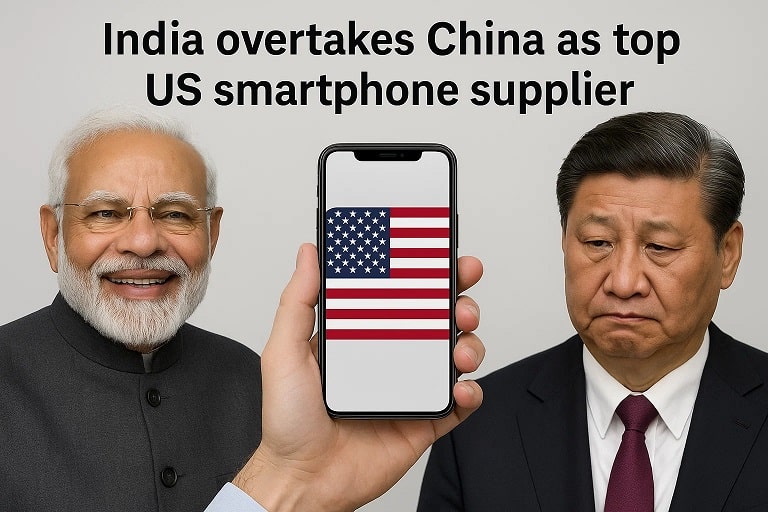India Overtakes China as Top US Smartphone Supplier in Historic Shift
New Delhi, August 10, 2025 – In a landmark development, India has surpassed China to become the leading supplier of smartphones to the United States in the second quarter of 2025, driven by a seismic shift in global supply chains and Apple’s strategic pivot to Indian manufacturing. According to a July 2025 report by research firm Canalys, smartphones assembled in India accounted for 44% of U.S. imports in Q2 2025, up from just 13% a year earlier, while China’s share plummeted from 61% to 25%. This milestone, fueled by a 240% surge in India’s smartphone exports, underscores the country’s rising prowess in high-tech manufacturing and its growing role in the global electronics ecosystem.
A Dramatic Supply Chain Realignment
The shift stems from escalating U.S.-China trade tensions and tariff uncertainties, prompting major smartphone makers to diversify production away from China. Apple, the primary driver, has accelerated its “China Plus One” strategy, ramping up iPhone production in India to mitigate risks from U.S. tariffs, which reached triple-digit rates on Chinese goods in early 2025. In Q2 2025, India exported 39 million smartphone units to the U.S., a 7% year-on-year increase, with Apple’s iPhone 16 and base models leading the charge. Vietnam also gained, with its share rising to 30% from 24%, largely due to Samsung’s manufacturing hub there.
India’s ascent is starkly illustrated by the decline in China’s dominance. In Q2 2024, China supplied 61% of U.S. smartphone imports, but by Q2 2025, this fell to 25%, reflecting a strategic reorientation by manufacturers wary of geopolitical risks. Canalys Principal Analyst Sanyam Chaurasia noted, “India became the leading manufacturing hub for smartphones sold in the U.S. for the first time in Q2 2025, largely driven by Apple’s accelerated supply chain shift amid an uncertain trade landscape between the U.S. and China.”
Apple’s Pivotal Role
Apple’s expansion in India has been the linchpin of this transformation. The company has scaled up production in Tamil Nadu, with suppliers like Foxconn, Pegatron (now under Tata Electronics), and Tata Electronics assembling iPhones for export. In Q1 FY26 (April–June 2025), Apple accounted for nearly 70% of India’s smartphone exports, with iPhone shipments to the U.S. surging 53% year-on-year to 23.9 million units, 78% of which targeted the U.S. market. Notably, Apple began assembling iPhone 16 Pro models in India, though it still relies on China for high-end model supply due to the latter’s mature infrastructure.
Other brands, including Samsung and Motorola, have followed suit, albeit more cautiously. Samsung’s exports from India grew 38% in Q2 2025, driven by its Galaxy A-series, while Motorola increased output modestly, still leaning on Chinese facilities. Both lag behind Apple’s aggressive shift, with Samsung primarily producing in Vietnam.
Tamil Nadu: India’s Manufacturing Powerhouse
Tamil Nadu has emerged as the epicenter of India’s smartphone export boom, hosting key Apple suppliers like Foxconn, Salcomp, and Corning in industrial corridors such as Sriperumbudur and Hosur. The state’s electronics exports reached $14.65 billion in FY2025, comprising 41% of India’s total electronics exports, with ambitions to hit $50 billion in three years. Tamil Nadu’s Minister for Industries, T.R.B. Rajaa, credited the state’s skilled workforce and infrastructure, bolstered by the April 2025 Electronics Components Manufacturing Scheme, which aims to attract $3.43 billion in investments and create 60,000 jobs.
This industrial ecosystem supports not just assembly but also component production, with firms like Corning (Gorilla Glass) and Salcomp (chargers) enhancing local supply chains. The state’s focus on high-value components, such as camera modules and Li-ion cells, aligns with India’s goal to move up the manufacturing value chain.
Broader Implications: Economic and Geopolitical
India’s rise as the top U.S. smartphone supplier reflects its growing economic clout. Mobile phone exports soared from $0.2 billion in 2017-18 to $24.1 billion in 2024-25, driven by the government’s Production Linked Incentive (PLI) scheme, which expanded manufacturing units from two in 2014 to 300 by 2025. Union Minister Ashwini Vaishnaw highlighted this growth, noting that electronics production has surged sixfold to $144 billion over the past decade, positioning India as the world’s second-largest mobile phone manufacturer.
Geopolitically, the shift aligns with U.S. efforts to reduce reliance on China, especially amid President Trump’s tariff policies, which imposed a 26% duty on Indian imports in April 2025 (later paused) and triple-digit tariffs on China. However, Trump’s recent call to curb Indian tech hiring, announced at a July 2025 AI Summit, introduces tensions, as India’s role in U.S. tech supply chains—both in hardware and talent—remains critical.
Challenges and Market Dynamics
Despite India’s gains, challenges persist. Manufacturing yields in India and Vietnam are lower than in China due to less experienced workforces and logistical hurdles, according to Renaud Anjoran of Agilian Technology. This impacts efficiency and cost, though India’s lower labor costs and PLI incentives offset some drawbacks. The U.S. smartphone market grew only 1% in Q2 2025, with Apple’s iPhone shipments dropping 11% to 13.3 million units, reflecting tepid demand amid tariff-driven inventory frontloading. Samsung, however, saw a 38% shipment increase to 8.3 million units, while Motorola, Google, and TCL held smaller shares.
Smaller vendors face mounting pressures. HMD Global, maker of Nokia phones, scaled back U.S. operations in 2025, citing tariff uncertainties and weak demand. With Apple, Samsung, and Motorola commanding over 90% of the market, niche players struggle to compete.
Sentiment and Future Outlook
On X, reactions range from pride to pragmatism. @IndianTechGuide celebrated India’s “historic” overtake, while @MeghUpdates hailed the 240% export surge as a triumph. Conversely, @RushDoshi cautioned that “there’s still much to do” to sustain this lead. Indian manufacturers aim to leverage this momentum, with Tamil Nadu targeting end-to-end high-tech production. However, U.S. tariffs and potential visa restrictions could complicate India’s role as a tech partner.
Looking ahead, India’s smartphone exports are poised to grow, with Apple planning to produce a quarter of its global iPhones in India by 2028. As the U.S. navigates trade tensions and India strengthens its manufacturing ecosystem, this shift could redefine global tech supply chains, positioning India as a linchpin in the West’s diversification strategy.
Conclusion: A New Tech Titan Emerges
India’s emergence as the top U.S. smartphone supplier marks a pivotal moment in global manufacturing, driven by Apple’s strategic shift and India’s industrial ambition. While challenges like efficiency gaps and U.S. trade policies loom, India’s trajectory—from a minor player to a tech powerhouse—signals a broader realignment. As Tamil Nadu powers this boom and companies like Tata join the fray, India is not just assembling phones but reshaping the future of global technology, one iPhone at a time.












